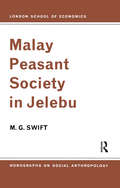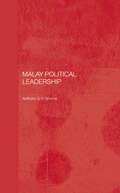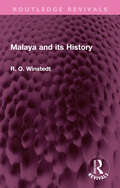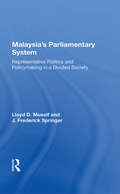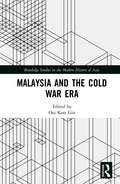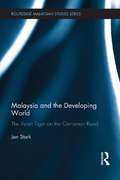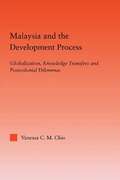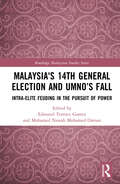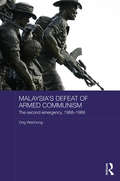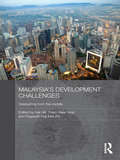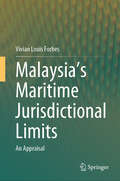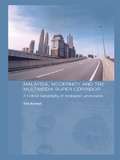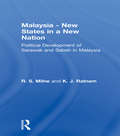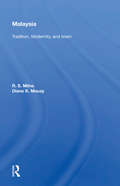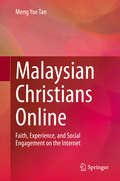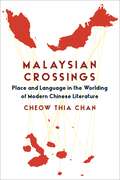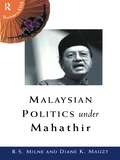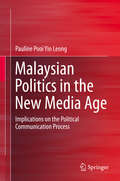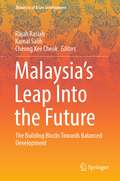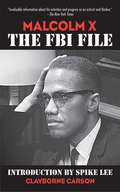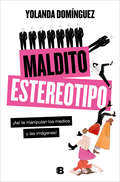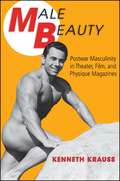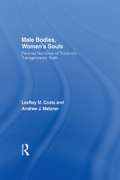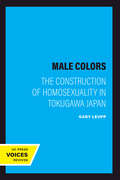- Table View
- List View
Malay Peasant Society in Jelebu (LSE Monographs on Social Anthropology #Vol. 29)
by M. G. SwiftFirst published in 1939 and long out of print, this book remains unique as the only full and detailed account by a social anthropologist of a complete pagan Polynesian ritual cycle. This new single-volume edition omits some of the Tikopia vernacular texts, but includes a new theoretical introduction; postscripts have also been supplied to some of the chapters comparing the performances of 1928-9 with those witnessed by Professor Firth on his second visit to Tikopia in 1952. There is a specially written Epilogue on the final eclipse of the traditional ritual, based on a third visit by the author during the summer of 1966.
Malay Political Leadership
by Tony ShomeThis book demonstrates how particular values and 'notions of leadership', which underpinned traditional Malay leadership, have played a crucial role in the political evolution of the modern Malaysian nation. The author discusses the nature of Malay 'notions of leadership', and considers this throughout the Malay world at the local as well as at the national level, and goes on to describe and analyse leadership from pre-independence leadership in the colonial period through the rule of Malaysia's four prime ministers. He draws on anthropology, psychology, and political and economic history to show how Malay leaders have kept within the established track of the Malay value system, responding in particular to the expectation of their people to provide a sense of national identity and unity against the complex background of the Malaysian 'mosaic', while addressing the needs of the wider multi-ethnic community. Throughout the evolutionary development of Malay leadership, symbolisms for the perpetuation of leadership veneration persisted in its institutions and in the sublime power of the sultans. The Malay case offers one of the most remarkable studies of leadership, in its attempt to maintain indigenous primacy in a large multi-racial environment, subscribing to western democracy for its governance while retaining conservative Islamic values. This book is a significant contribution to the understanding of the evolution of leadership. It begins with an explanation of the early Malay World belief system and progresses to the period of colonization and nationalism. It then follows through the dynamics of modern politics encapsulating the biographical profiles of all Malaysia's Prime Ministers - Tunku, Razak, Hussein, and Mahathir - in three aspects: national unity, the economy and foreign affairs. The analysis of Mahathir's leadership extends into the new millennium. This is the only book with biographical profiles of all of Malaysia's Prime Ministers. This book will be of interest to students, academics, politicians, foreign affairs specialists and any reader interested in leadership studies and about Malaysia's political and economic history.
Malaya and its History (Routledge Revivals)
by R. O. WinstedtFirst published in 1948, Malaya and its History is a history of Malaya ranging from the thousand years of Hindu influence to the eras of Portuguese and Dutch rule, and from the establishment of the British protectorate to Malayan independence in 1957. There are chapters on law, trade, industry and the social services. This book will be of interest to students of history, southeast Asian studies, and cultural studies.
Malayasia's Parliamentary System: Representative Politics And Policymaking In A Divided Society
by Lloyd D MusolfMalaysia, a new nation whose very existence depends on holding disparate ethnic groups in balance, is an example of a developing nation whose legislature does influence policy. This pioneering survey and analysis of the Malaysian parliament carefully documents and interprets the interaction of legislator, party, and voter in Malaysia. The study ind
Malaysia and the Cold War Era (Routledge Studies in the Modern History of Asia)
by Ooi Keat GinFrom the end of the Second World War in 1945 to the collapse of the Soviet Union in 1991, there was a great deal of turmoil, tension and violence in what became Malaysia as a result of the 1963 Federation; upheavals included the Malayan Emergency of 1948・1960, the independence of Malaya in 1957, Konfrontasi with Indonesia of 1963・1966, the Philippines’ claim to Sabah, the Sarawak Communist Insurgency (1962・1990) and the Second Malayan Emergency of 1968・1989. This book breaks new ground in arguing for a longer trajectory of the Cold War, tracing this phenomenon back to 1920s’ colonial Malaya and Sarawak. Many new research findings showing how Malaysia coped with and overcame the many trials, challenges and difficulties are presented here, further enriching the historiography.
Malaysia and the Developing World: The Asian Tiger on the Cinnamon Road (Routledge Malaysian Studies Series)
by Jan StarkAs Malaysia’s economy grows and flourishes, strong new links are being forged with other developing countries in the region and beyond. This book traces the ways in which age-old organizational, political, religious and trade networks between Nusantara, the Malay World, and Central Asia, East Africa and the Middle East have changed in recent years. The book argues that these old links are being revived by new forms of globalization, modernization and knowledge transfer that are developing and implementing non-western models of governance, often in direct reference to Islam. The book goes on to explain how, as Malaysia develops new links with Indian Ocean countries, many of them Muslim countries, a new style trading network is being formed, a network with Islamic characteristics, which echoes Indian Ocean Islamic trading networks of earlier times. Interspersed with interesting methodological insights into the latest network, transnational and spatial theories, the book provides detailed case studies of Malaysia’s and Southeast Asia’s trade and numerous other links with Indonesia, Egypt, Zanzibar, Comoros and Central Asia, and concludes by assessing how Malaysia’s and ASEAN’s new style network is likely to develop and influence wider global networks. Written with a depth of knowledge reflective of the author’s many years of research throughout Asia, this book gives a real insight into how Malaysia’s mentalities, traditions and ways of thinking are being applied to its interactions with its immediate neighbours and the wider world.
Malaysia and the Development Process: Globalization, Knowledge Transfers and Postcolonial Dilemmas (Studies in International Relations)
by Vanessa C.M. ChioDrawing on recent deconstructions in anthropology, postcolonial studies, and critical sociology, Malaysia and the Development Process situates and explores the phenomenon of international knowledge transfers within the context of globalization. Based on primary and secondary research, and a series of 'experiential' reflections, fieldwork was conducted in two foreign electronics multinationals and a variety of public and semi-public institutions. The findings reassess issues of knowledge, power, subjectivity and agency, and the relations between the West and the non-West, as they are negotiated between and within multinational workplaces and local agencies in Malaysia.
Malaysia's 14th General Election and UMNO’s Fall: Intra-Elite Feuding in the Pursuit of Power (Routledge Malaysian Studies Series)
by Edmund Terence Gomez Mohamed Nawab Mohamed OsmanThe 2018 Malaysian General Election will stand as a major defining event in Malaysian history, when the ruling Barisan Nasional coalition unexpectedly lost power in the country they had ruled for over half a century. This volume brings together scholars who assess one fundamental factor that brought about this game-changing event in Malaysian politics: intra-elite feuding in the leading Malay-based political parties. This study provides an analysis of individual state politics as well as national trends shaped by the actions of leaders in government and the opposition. An indispensable guide for scholars studying the politics of Malaysia and of Southeast Asia more broadly, it will be of great interest for all readers with an interest in Malaysian politics.
Malaysia's Defeat of Armed Communism: The Second Emergency, 1968-1989 (Routledge Studies in the Modern History of Asia)
by Ong WeichongThe Malayan Communist Party’s (MCP) decisive defeat in 1960 led many academics and Counterinsurgency (COIN) experts to overlook the resurrection of its armed struggle in 1968. Most scholars continue to regard the so-called ‘Second Emergency’ in Malaysia (1968-1989) as a non-event, and most of the recently published work on the MCP tends to focus on the earlier Malayan Emergency (1948-1960). This book looks at the Second Emergency through recently released archival material from the National Archives in London, the National Australian Archives and the Australian War Memorial, as well as interviews with military and diplomatic officers from the UK and Thailand. It presents the first serious strategic and operational study of the Second Emergency, and analyses three areas of historical significance: the CPM’s strategy for armed struggle in the Second Emergency; the actual effectiveness of the CPM’s subversive propaganda on its target population and most importantly; the counterinsurgency (COIN) response and strategy of the Malaysian state and to a lesser extent the counter-subversion strategy of Singapore in the post-colonial era.
Malaysia's Development Challenges: Graduating from the Middle (Routledge Malaysian Studies Series)
by Hal Hill Tham Siew Yean Ragayah Haji Mat ZinThis book examines the various economic, political and developmental policy challenges that Malaysia faces in her shift from a middle income to high-income economy. This issue is of great interest to academics, policy makers and development practitioners in the developing world, particularly in middle-income economies where there is a widespread concern about the challenges of managing such a transition. Malaysia is one of the developing world's greatest success stories. The book argues that as one of the developing world's most open economies, with a reputation for prudent macroeconomic management, Malaysia has achieved consistent growth since independence. It has moved from a largely resource-based economy to a multinational-led, export-oriented, industrial economy. Despite this success, Malaysia, like other developing countries, is currently at a crossroads in its development strategy; it is in danger of being unable to graduate to the level of more advanced economies - such as Korea, Taiwan and Singapore - but with the basis of its success at risk from competition from efficient, lower-wage countries - such as China, India and Vietnam. Moreover, there are new threats to the political stability and affirmative action programmes which have successfully held together a very racially diverse population.
Malaysia's Maritime Jurisdictional Limits: An Appraisal
by Vivian Louis ForbesThe book adopts an interdisciplinary approach to maritime boundary delimitation and uses Malaysia as a case study. The country may be considered 'zone-locked' in the context of the Law of the Sea.Administrators, political scientists, academic researchers and university students will benefit from the contents of this book. Apart from its well written narrative, perhaps the most important aspect of the work most perhaps series of beautifully drawn maps and diagrams accompanied by detailed captions or commentaries, a unique collection worthy of publication on its own.
Malaysia, Modernity and the Multimedia Super Corridor: A Critical Geography of Intelligent Landscapes (Routledge Pacific Rim Geographies)
by Tim BunnellBased on fieldwork in Malaysia, this book provides a critical examination of the country's main urban region. The study first provides a theoretical reworking of geographies of modernity and details the emergence of a globally-oriented, 'high-tech' stage of national development. The Multimedia Super Corridor is framed in terms of a political vision of a 'fully developed' Malaysia before the author traces an imagined trajectory through surrounding landscapes in the late 1990s. As the first book length academic analysis of the development of Kuala Lumpur Metropolitan Area and the construction of the Multimedia Super Corridor, this work offers a situated, contextual account which will appeal to all those with research interests in Asian Urban Studies and Asian Sociology.
Malaysia: New States in a New Nation
by R.S. Milne K.J. RatnamFirst Published in 1974. Routledge is an imprint of Taylor & Francis, an informa company.
Malaysia: Tradition, Modernity, And Islam
by R. S. MilneMalaysia has many problems in common with other developing countries—including the difficult task of achieving economic progress and modernization while retaining useful traditional values, reducing poverty, and minimizing dependence on the export of a few primary products. It also has a remarkable, if not unique, diversity of cultures. Its ethnic divisions (approximately 47 percent Malay 34 percent Chinese, 9 percent Indian, and 10 percent "other") are deep, reflecting differences in race, language, culture, and religion. At present, the main danger of serious ethnic tension arises from the impact of the Islamic resurgence. The Malays, who are dominant politically, are Muslims, but very few Chinese, the second largest ethnic group, are Muslims. It is especially remarkable, given this ethnic mix, that Malaya (which became Malaysia in 1963) achieved independence peacefully (in 1957), has experienced no military coups or takeovers, and has regularly held elections. This book examines Malaysia's history, population, social structure, politics, and economics as well as its climate, agriculture, and wildlife and seeks to explain why, despite its inherent ethnic tensions, Malaysia has survived and even prospered.
Malaysian Christians Online: Faith, Experience, and Social Engagement on the Internet
by Meng Yoe TanMany facets of social life are now intrinsically linked to the Internet through increasing dependence of user-centric platforms like blogs, social-networking websites, online forums, and open source websites. The Malaysian Church is not exempt from having to negotiate with an increasingly tech-savvy and networked community of believers. Based primarily on Internet ethnography and interviews with Christian bloggers and church pastors, this book looks at how the Internet is a component of “everyday religion” in the lives of Malaysian Christians at individual, institutional, and national levels. It examines the ways in which online Christian expressions are increasingly integrated into the everyday religious routines of Christians for the development of their personal identities and inter-religious interactions. This book also shows how the spiritual authority of church pastors can be both challenged and reinforced through the creative use of online tools. It addresses some of the creative ways in which Christians utilise the Internet to engage with national socio-political issues within the context of restrictive and controlled mainstream media, as well as the ongoing discourse with Islam in the country. Through a selection of case studies, this book shows that while the Internet may be “free”, the users of the Internet are not necessarily so. While the Internet has provided Malaysian Christians with new tools to experience their faith in new ways, several aspects of “old” offline socio-cultural habits persist online. These, in turn, lead to a robust and growing environment of Internet Christianity in Malaysia. This timely book will be of interest to scholars in religious studies, media and communications, and cultural studies in Southeast Asia.
Malaysian Crossings: Place and Language in the Worlding of Modern Chinese Literature (Global Chinese Culture)
by Cheow Thia ChanMalaysian Chinese (Mahua) literature is marginalized on several fronts. In the international literary space, which privileges the West, Malaysia is considered remote. The institutions of modern Chinese literature favor mainland China, Taiwan, and Hong Kong. Within Malaysia, only texts in Malay, the national language, are considered national literature by the state. However, Mahua authors have produced creative and thought-provoking works that have won growing critical recognition, showing Malaysia to be a laboratory for imaginative Chinese writing.Highlighting Mahua literature’s distinctive mode of evolution, Cheow Thia Chan demonstrates that authors’ grasp of their marginality in the world-Chinese literary space has been the impetus for—rather than a barrier to—aesthetic inventiveness. He foregrounds the historical links between Malaysia and other Chinese-speaking regions, tracing how Mahua writers engage in the “worlding” of modern Chinese literature by navigating interconnected literary spaces. Focusing on writers including Lin Cantian, Han Suyin, Wang Anyi, and Li Yongping, whose works craft signature literary languages, Chan examines narrative representations of multilingual social realities and authorial reflections on colonial Malaya or independent Malaysia as valid literary terrain. Delineating the inter-Asian “crossings” of Mahua literary production—physical journeys, interactions among social groups, and mindset shifts—from the 1930s to the 2000s, he contends that new perspectives from the periphery are essential to understanding the globalization of modern Chinese literature. By emphasizing the inner diversities and connected histories in the margins, Malaysian Crossings offers a powerful argument for remapping global Chinese literature and world literature.
Malaysian Politics Under Mahathir (Politics in Asia #10)
by Diane K. Mauzy R. S. MilneA hard-hitting and readable book which examines Mahathir's character, his ideas and policies and relates them to the social, economic and political setting inside Malaysia. Up until recently, high rates of economic growth and a striking reduction in poverty have been the hallmarks of this vibrant Tiger economy. Mahathir's success has now been placed in jeopardy by the recent economic crisis, and his rule is coming under hostile scrutiny.As one of the most controversial political figures in South-east Asia, Mahathir's success at managing ethnic tensions, policies of industrialization, modernization and foreign policy are explored, as are his grandiose projects, his human rights record and approach to corruption. Milne and Mauzy, leading authors in this field, assess Mahathir's rule within this context as well as the abrupt dismissal from office, arrest and trial of Anwar Ibrahim, Mahathir's deputy, in late 1998.
Malaysian Politics in the New Media Age: Implications on the Political Communication Process
by Pauline Pooi Yin LeongThis book provides a comprehensive overview of the impact of the Internet on Malaysian politics and how it has played a pivotal role in influencing the country’s political climate. It lays out the background of Malaysia’s political history and media environment, and addresses the ramifications of media-isation for the political process, including political public relations, advertising and online campaigns. The book examines the Internet’s transformative role and effect on Malaysian democracy, as well as its consequences for political actors and the citizenry, such as the development of cyber-warfare, and the rise of propaganda or “fake” news in the online domain. It also investigates the interplay between traditional and new media with regard to the evolution of politics in Malaysia, especially as a watchdog on accountability and transparency, and contributes to the current discourse on the climate of Malaysian politics following the rise of new media in the country. This book is particularly timely in the wake of the 2018 Malaysian general election, and will be of interest to students and researchers in communications, politics, new media and cultural studies.
Malaysia’s Leap Into the Future: The Building Blocks Towards Balanced Development (Dynamics of Asian Development)
by Rajah Rasiah Kamal Salih Cheong Kee CheokThis book presents the future development of Malaysia. It puts together building blocks to achieve a better future. These blocks are poverty and income inequality, population, demography and urbanization, growth and technological progress, education, human capital and skills, finance, labor, the environment, and health care. It examines the reasons for the decline in the agricultural sector with an emphasis on food security. It discusses Malaysia’s economic growth and structural change compared to some of the Northeast East Asian and Southeast Asian countries. It explains the projections of population and demographic change and its bearing on government policies. It evaluates the country’s education sector and discusses the strategies to improve its role in the country further. It argues for replacing ethnic-based approaches with a needs-based system for the future direction to build a plural Malaysia. This insightful book is of interest across several fields, including demography, economic development, and urbanization.
Malcolm X: The FBI File
by Clayborne Carson Spike Lee David GallenThe FBI has made possible a reassembling of the history of Malcolm X that goes beyond any previous research. From the opening of his file in March of 1953 to his assassination in 1965, the story of Malcolm X's political life is a gripping one. Shortly after he was released from a Boston prison in 1953, the FBI watched every move Malcolm X made. Their files on him totaled more than 3,600 pages, covering every facet of his life. Viewing the file as a source of information about the ideological development and political significance of Malcolm X, historian Clayborne Carson examines Malcolm's relationship to other African-American leaders and institutions in order to define more clearly Malcolm's place in modern history. With its sobering scrutiny of the FBI and the national policing strategies of the 1950s and 1960s, Malcolm X: The FBI File is one of a kind: never before has there been so much material on the assassination of Malcolm X in one conclusive volume.
Maldita entre todas las mujeres: Testimonios y reflexiones de feminicidios y de victimas de este delito
by Saskia Niño de RiveraNo es maldita la mujer asesinada porque era malvada o perversa, sino porque cayó sobre ella la maldición de ser víctima de un feminicida; maldita porque sobre su muerte se abrieron las horas más trágicas y dolorosas para su familia. Más de una decena de mujeres es asesinada a diario en México. Y con cada muerte se abre una herida profunda en sus familias que nunca cierra ni deja de doler. ¿Por qué se mata a las mujeres en este país? ¿Cómo viven las familias después de esta tragedia? Saskia Niño de Rivera ofrece en este libro de testimonios y revelaciones sin precedentes las respuestas y las explicaciones para entender desde lo más hondo este delito y el purgatorio que desencadena. A partir de las confesiones de agresores de mujeres y feminicidas, podemos saber de forma directa las causas y contextos de estas muertes, cómo fue la infancia de los perpetradores, quién los educó, en qué momento la violencia que soportaron se convirtió en estigma. Y, en consecuencia, qué suplicio viven las madres de las mujeres violentadas, por qué el duelo se agudiza cuando empiezan las investigaciones y se enfrentan a la insensibilidad de juezas, ministerios públicos, policías, funcionarias o abogados: ¿por qué como sociedad nos hemos vuelto tan indiferentes? Maldita entre todas las mujeres es una obra terrible y enternecedora que ahonda en las vidas de los criminales y las acciones de quienes buscan la justicia para sus hijas, madres o hermanas muertas. Con una visión sensible y muy humana, el libro confirma que hoy más que nunca debemos entender intensamente el delito para evitarlo, no se trata de justificar ni revictimizar, urge una mirada consciente para también decir basta a la corrupción, impunidad e ineptitud del Sistema de Impartición de Justicia de México.
Maldito estereotipo
by Yolanda DomínguezUn análisis crítico sobre por qué funcionan los estereotipos y qué hacer para combatir las desigualdades que generan En Maldito estereotipo, Yolanda Domínguez analiza de manera crítica, irónica y reveladora distintos aspectos culturales y sociales relacionados con la influencia de las imágenes y nos explica cómo y por qué funcionan los estereotipos, qué se esconde tras la fotografía de moda, cuál es el papel que tienen las imágenes en la construcción de nuestra identidad y qué pautas podemos seguir para utilizarlas de una manera más comprometida, que contribuya a combatir la desigualdad. «No consideramos la imagen como un signo que hay que interpretar e incluso contrastar, sino que la consideramos directamente como la realidad y ese es uno de sus mayores peligros. Consumimos tal cantidad de imágenes que aplicamos un nivel de lectura muy superficial basado en lo emocional, lo que nos mantiene en un grado muy básico de entendimiento, más animal y menos racional […] La repetición de los códigos visuales heredados, sumada a la necesidad de simplificar, da lugar a los estereotipos que arrastran y refuerzan juicios morales, limitando nuestras posibilidades y la forma de relacionarnos e incluso llegando a provocar lo que representan.»
Male Beauty: Postwar Masculinity in Theater, Film, and Physique Magazines
by Kenneth KraussIn the decades that followed World War II, Americans searched for and often founds signs of a new masculinity that was younger, sensitive, and sexually ambivalent. Male Beauty examines the theater, film, and magazines of the time in order to illuminate how each one put forward a version of male gendering that deliberately contrasted, and often clashed with, previous constructs. This new postwar masculinity was in large part a product of the war itself. The need to include those males who fought the war as men—many of whom were far younger than what traditional male gender definitions would accept as "manly"—extended the range of what could and should be thought of as masculine. Kenneth Krauss adds to this analysis one of the first in-depth examinations of how males who were sexually attracted to other males discovered this emerging concept of manliness via physique magazines.
Male Bodies, Women's Souls: Personal Narratives of Thailand's Transgendered Youth
by LeeRar CostaGet a detailed look at the Thai sex/gender system-through analysis of the personal stories from transgendered youth in ThailandThe Thai term sao braphet song (a "second type of woman") describes males who reject the gender of masculinity for femininity. Male Bodies, Women&’s Souls: Personal Narratives of Thailand&’s Transgendered Youth uses the narrative method, stories in the words of these "second type of women" to analyze these transgendered experiences. This previously ignored perspective of the Thai sex/gender system gained through this theoretical and methodological approach offers students and general readers a rich, more readily accessible foundation of knowledge about gendered subjectivity and sex/gender systems.Male Bodies, Women&’s Souls: Personal Narratives of Thailand&’s Transgendered Youth features in-depth, autobiographical life histories from individual Thai transgendered youth. Life stories, told in the participants&’ own words, provides an engaging, at times touching, always insightful look at Thai culture&’s sex/gender system. The authors then expertly analyze the narratives to illuminate common themes and constructions within this group, allowing an opportunity for contrast and discussion on transgender experiences in other nations. Male Bodies, Women&’s Souls: Personal Narratives of Thailand&’s Transgendered Youth analyzes the major themes in the stories, including: identities definitions and descriptive labels etiologies of sao braphet song-ness the notion of acceptance narrator motivations for participating in the projectMale Bodies, Women&’s Souls: Personal Narratives of Thailand&’s Transgendered Youth is illuminating, reflective reading for educators, undergraduate students, graduate students, researchers, or anyone interested in discovering more about transgenderism in a specific cultural context.
Male Colors: The Construction of Homosexuality in Tokugawa Japan
by Gary LeuppTokugawa Japan ranks with ancient Athens as a society that not only tolerated, but celebrated, male homosexual behavior. Few scholars have seriously studied the subject, and until now none have satisfactorily explained the origins of the tradition or elucidated how its conventions reflected class structure and gender roles. Gary P. Leupp fills the gap with a dynamic examination of the origins and nature of the tradition. Based on a wealth of literary and historical documentation, this study places Tokugawa homosexuality in a global context, exploring its implications for contemporary debates on the historical construction of sexual desire.Combing through popular fiction, law codes, religious works, medical treatises, biographical material, and artistic treatments, Leupp traces the origins of pre-Tokugawa homosexual traditions among monks and samurai, then describes the emergence of homosexual practices among commoners in Tokugawa cities. He argues that it was "nurture" rather than "nature" that accounted for such conspicuous male/male sexuality and that bisexuality was more prevalent than homosexuality. Detailed, thorough, and very readable, this study is the first in English or Japanese to address so comprehensively one of the most complex and intriguing aspects of Japanese history.
